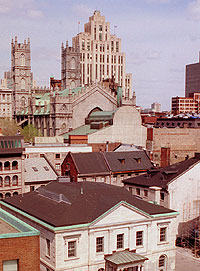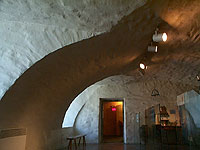|
|
 |
| Right from
the very beginning, Old Montreal has been swept by
a number of waves of change, mainly related to its role
as a constantly evolving hub. The historic city centre
of this North American metropolis is still clearly in
evidence today, something quite rare and remarkable in
North America, and even shows traces of the different
stages in its evolution. |
|
 |
 |
 |
 |
 |
 |
FROM PREHISTORIC OCCUPATION
TO PRE-INDUSTRIAL TRANSIT POINT There
are still many traces showing that the site chosen by
the city's founders had long been a Native stopping-place
and occasional settlement. In the crypts of the museums
in Old Montreal, flint arrowheads and stone tools, among
other artifacts, are evidence that material goods were
used and traded here, often brought from far away. At
Pointe-à-Callière, visitors can see the
archaeological remains of the first Catholic cemetery
and sections of the early 18th-century fortifications.
In the Champ-de-Mars, a long section of the foundations
of the fortifications is visible: the fortified town
gave France, and later England, a valuable logistical
base for the continent. The vaults of the Château
Ramezay, the building used by the Compagnie des Indes
occidentales for its fur exports, are another reminder
of 18th-century Montreal. |
|
 |
 |
|
 |
|
The store-residences dating
from pre-industrial Montreal, (with the store on the
ground floor and living quarters upstairs) from the
18th and early 19th centuries, warehouses, the Custom
House dating from 1836 and the Bonsecours Market, opened
in 1847, are all evidence of the extensive interchanges
between Great Britain and Montreal, its Canadian hinterland.
Facilities and buildings such as these, related to transport
and trade, obviously depict only some of the activities
conducted in the city, as the imposing institutional
buildings from the 17th, 18th and 19th centuries remind
us.
|
|
 |
|
|
 |